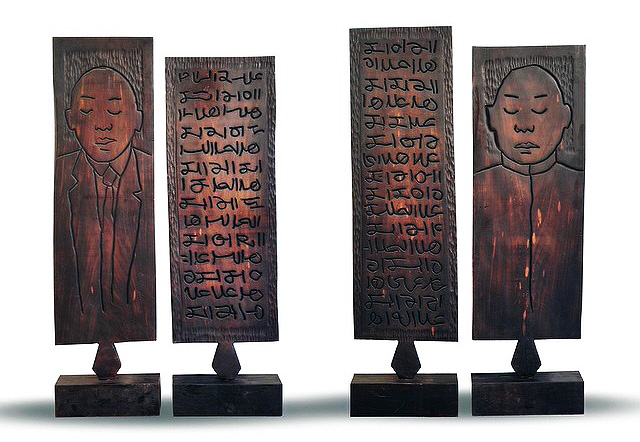These logs have been with me for years. Sometime I have to wait a long time to discover the form in a piece, says sculptor Abdul Jabbar Gull, whose works in wood and fiberglass were recently exhibited at Karachi’s Canvas Gallery.
A tall figure that stretches to the height of 67 inches dominates the show. Her arms almost hugging her as she sways to some inner rhythm, the vertical folds of her long dress follow the natural spread of the base of the trunk where it grips the earth. Jabbar takes his cue from nature, this is evident in almost all pieces, particularly the bending man that comes from a curved log and the praying woman, where the sculptor has taken advantage of a branch. Without imposing his will on the natural shapes, Jabbar establishes the continuum. The tree that has flowered and fruited for many seasons through his creative vision is allowed to take on a new life.
Born in Mirpurkhas, on the edge of the vast Thar Desert, Gull grew up in a rustic environment. At the NCA, initially he took up graphic design only to change it later when he could no longer ignore the inner voice that sought the challenge of the three dimensional forms. Encouragement came from the response to his degree show and the generosity of collector Shehla Saigol, who provided him with studio facilities in Lahore.
This is Gull’s first solo, and earlier experiments in fiberglass can also be seen here. It traces his exploration of the human form in the two media. In fiberglass, he concentrates on the replication of the human form and facial expression unlike his wooden pieces where the body of wood and its characteristics dominate the aesthetic problem. Here, the sculptor handles the wood with great sensitivity but he is not always successful in culling out a human form that is as graceful in limb and features to harmonize with the elongated form. It is because of this that some pieces call out for a re-look by the sculptor.
I find wood to be a sympathetic medium. Its organic nature enhances my quest and continues it,
explains Gull. The surface treatment testifies this, where the warm honey tones of sheesham has been burnished to a glow. The natural patterns are consciously integrated to evoke fabric patterns on garments. In the mother and child sculpture, not only does the extended stump suggest an infant form but the two are also interlinked by the concentric whorls in the wood and act as emblems of a genetic link. Wherever Gull has darkened the wood, no pigment has been used; the surface has been seared with a high temperature flame. As the carbon is rubbed and waxed, the layers of the trunk take one deep tone. After stripping away the sapwood, Gull carves by hand. During this meditative journey, the sculptor lives with each stage, shaping and caressing the organic medium. Forming a symbiotic relationship where one sustains the other. The wood in this process enables the sculptor to search within before he can share the discovery with others. This relationship is spontaneous and organic. And probably finds its echo in an age when man first found wood as an expressive medium along with stone and bone. As a living organism, wood has a un explainable attraction for man. May it be gnarled driftwood bleached by the harshest elements, sun and water, that in different circumstances are its nurturers, or in its more tame form, furniture.
Wood communicates at a subconscious level in our everyday existence till it is given a voice in the idiom of a sculptor. While looking deeply at “the sensuous dialectic between nature and culture” in her book Overlay, Western art critic, Lucy Lippard and goes on to say that
…one of the art’s functions is to recall that which is absent whether it is history, or the unconscious, or form or social justice
In the work of Gull, the medium can be taken as part of its content as it seeks to reflect his need for a harmonious space in a world under threat by technological progress and invasion by manmade materials. It is his search in the concrete urban landscape of Karachi a manmade desert where flowers only bloom in private homes or ‘sponsored’ traffic islands.
Through his life-size human forms in wood, Abdul Jabbar Gull appears to reach out for a memory that gives him the comfort of an intrinsic union.
Source: The Review, DAWN, June 1-7, 2000

